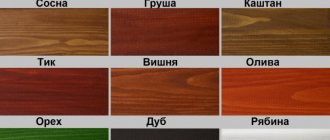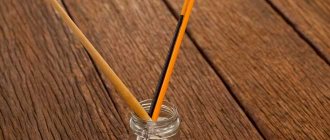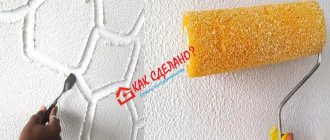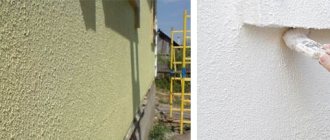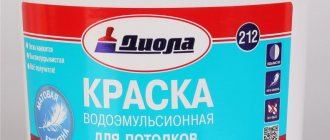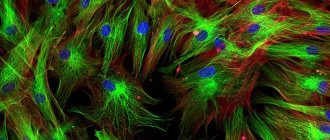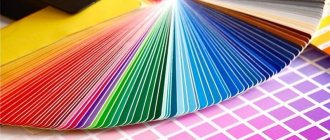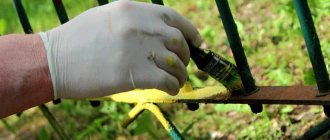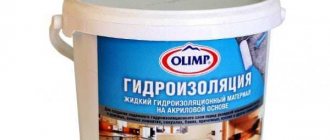An obligatory stage of interior design is decorating walls and ceilings. For several decades, the most popular method has been dyeing. Compared to other options, this is a budget method, for which you do not always need to hire specialists. By visiting any hardware store or market, you will purchase all the necessary attributes (brushes, rollers and pallets) to carry out the work on your own.
You must take into account that the surface to be painted must be prepared in a specific way. Most likely at this stage you will need the help of an experienced foreman. But in the future, a well-prepared wall or ceiling can be repeatedly painted and repainted in the desired color, if you use a water-based emulsion for this.
general information
Water emulsion is a general classifier that combines different types of water emulsions with differing technical and quality characteristics.
Such dyes are wear-resistant, environmentally friendly, do not fade in the sun and are odorless, do not crack, are easy to apply, and dry quickly. They paint almost any material, with the exception of smooth metals and ceramics. It is precisely because water-based paint contains more water that it does not stick to them.
Another important advantage is the affordable price.
The color palette offered on the market is striking in its diversity. Colorists in salons help you get the right shade for free or for a small fee.
But there is also a drawback to this kind of dyes. At low temperatures and improper use of the room, mold and mildew may appear on the painted surface. Well-known and reliable manufacturers add special additives to the paint that solve this problem.
It must be remembered that there is a large percentage of fakes in stores. Experts advise purchasing products only from well-known brands. A low-quality product does not fit well, wears out quickly, cracks and has a high consumption.
Types of water emulsion
The first chapter said that in the 20s of the last century it was possible to paint with water-based paint exclusively based on PVA. But, in the 30s, butodiene-styrene was synthesized in Germany. There are already 2 types of water emulsion. Now there are 5 of them:
- Polyvinyl acetate. They are environmentally friendly and inert to aggressive environments. PVA-based compositions also do not care about ultraviolet - the paint does not fade in the sun.
- Silicone. The film is made from silicone resins. This coating is the most durable and breathable.
- Acrylic. Also based on resins, but acrylic. This concept generalizes polymers based on methacrylic and acrylic acids. Acrylic water-based paint can stick (subject to prior impregnation with primer) even on smooth metal. Wood, plastered surfaces, glass, brick and concrete are also coated with acrylic water-based emulsion. On any surface, the paint can withstand 5 thousand washes. There is a division for:
-just acrylic
-acrylic-butadiene styrene
-acrylic-polyvinyl acetate
- acrylic silicone
Water-based paint comes in a variety of colors
All 4 listed varieties of acrylic paints are united by the term “latex”. The particles in them are highly elastic polyurethane foams. This is synthetic latex. It has a natural counterpart, secreted by some plants. However, like natural rubber, it is expensive.
- Mineral. These are those in which crushed minerals and rocks are mixed. The service life is reduced to 5 years. But this paint adheres well to “bare” concrete.
- Silicate. Silicates are silicon oxides. In the periodic table it is called silicium. One of the silicates is glass. This is what paint contains in liquid form. This one lasts about 20 years.
Since the basis of the water emulsion is polymers, it means that they need to be obtained. This can be done separately, and then added to the water. Then the paint is secondary (artificial). The second way is to take the monomer and polymerize it in water. In this case, the paint is primary (synthetic).
There is also a division according to the direction of application of the water-based emulsion. Highlight:
- primers that serve as a basis for further painting, designed to level the base and improve adhesion to it
- façade paints intended for exterior use, resistant to weathering, chemical influences, and water
- water-based emulsions for interior work, designed for mild operating conditions
- special paints containing additives that provide the coating with fire resistance and other non-standard properties
Some paints are tinted during production. The presence or absence of a coloring pigment is the final reason for classifying water-based emulsions. Accordingly, there is white water-based paint and colored paint.
Acrylic water-based paint
This is the most versatile and popular paint today. Unlike conventional water-based mixtures, acrylic is highly moisture resistant. Ceilings and walls painted with this composition can be washed with any detergent.
In addition, the emulsion has the following parameters:
- easy to apply (roller, brush, spray gun) by an inexperienced user;
- lays down smoothly without gaps or drips;
- does not change color over time when exposed to sunlight;
- can even be applied to metal that has been previously primed;
- odorless, non-toxic;
- the painted surface is not susceptible to the appearance of fungus.
- acrylic paint can cover cracks up to 1 mm wide.
Polyvinyl acetate water emulsion
This material can only be used in dry rooms. When subjected to mechanical stress, it quickly wears out and cracks. There is also a fairly large list of restrictions on the impossibility of application on various surfaces (metal, chalk, lime, alumina or vitriol). That is why it is the most inexpensive type of water-based dye.
Latex water emulsion
Thanks to the latex included in the dye, when it dries, a special crystalline structure is formed on the surface, which does not allow moisture to pass through. Ceilings painted with latex paint can even be washed with alkaline compounds. On the presented photos of latex water-based paints there are specific symbols that you should pay attention to. Depending on the specified parameter, your wall can be mirror, glossy or silky matte.
This type of emulsion is the most expensive among the line. It is distinguished by the presence of all positive properties and special abrasion resistance.
There is one drawback - deterioration in quality indicators at low temperatures. It is very important that the room to be painted is well heated.
Selecting paint based on the main component
Anyone who decides to make repairs with their own hands is faced with a choice of paints, which are presented on the market in a huge assortment. An inexperienced consumer can hardly figure out which water-based paint is better if products with the same name indicate differences in the composition of the components.
The main difference in all types of water-based paints is the basic composition of the aqueous polymer dispersion. The harmlessness of the paint is due to the absence of organic substances in its composition. Additives include stabilizers and emulsifiers.
Silicone water-based paint
Able to hide small cracks and chips. Manufacturers allow this type of water-based emulsion to be applied to plaster in one layer.
Silicone water emulsion is most often recommended for painting ceilings, surfaces in showers and bathrooms. Painted walls, thanks to the silicone included in the composition, practically do not get dirty.
Its technical characteristics fully justify the high price tag.
Pros and cons of water emulsion
Water-based paint for walls to be actively used in the post-war period. Many plants and factories were destroyed. Other buildings were also destroyed. Restoration was required quickly and cheaply.
The emphasis was on materials that, roughly speaking, could be produced in a garage. Then this became an advantage of the water-based emulsion. Now, the ease of its production is partly a disadvantage, allowing the production of fakes and goods of dubious quality.
Other disadvantages of water-based emulsion include:
- Instability to water. Since the polymers are initially dissolved in it, the same thing happens when moisture gets on the already dry paint. Most of its types can be completely washed off with water.
- Limited temperature regime for painting surfaces. If the indicator is less than +5 degrees, work is impossible.
Water emulsion has more advantages. This includes a wide range of colors and the possibility of tinting the original white paint (manually or on a special machine). Color for water-based paint is sold in powder or paste form. Quick drying is also an advantage. After just a few hours, the painted surfaces can be touched.
Another plus is the long service life. Minimum 5 years, maximum 2 decades. Throughout the entire period, the paint prevents combustion, withstanding high temperatures. Therefore, it is recommended to use water-based emulsion, for example, in wooden houses.
Additionally, the paint hides small cracks in the base. If their width is no more than 2 millimeters, there is no need to putty them first. Cracks are permanently eliminated on the paint itself. After the water evaporates, the film remains elastic for at least several years.
The advantages include the simple application of water-based emulsion. It does not drain, whether the surfaces are horizontal or vertical. The composition goes on smoothly and is easily washed off from areas where it got accidentally.
How to choose which paint to buy
Each manufacturer indicates on the packaging what type of paint the buyer purchases. A consultant can help you with your choice.
The annotations for water emulsions indicate its consumption per 1 sq.m. Surfaces, degree of roughness, type of work that can be carried out with its help.
Most emulsions are marked “interior”, meaning that they are applicable to any surface - floors, walls, ceilings, columns, etc. Some types of paints have a special purpose for the ceiling. You must read the label carefully.
How to paint with water-based paint
If you decide to paint the ceiling yourself, the first step is to calculate the paint consumption per 1 sq.m. From the amount received, calculate how much material you will need for the entire surface and add 10-15% for force majeure.
Before painting, the surface must be leveled and all cracks and holes removed. Under a thin layer of paint, all flaws will be clearly visible.
If you pre-coat the ceiling with a primer, you will reduce paint consumption, get rid of dust and improve adhesion to the water-based emulsion.
A little secret - if you don’t have a primer, or you don’t know how to carry out such work, dilute the same paint in a 1:1 ratio with water.
First brush over corners and seams in a thin layer and only then apply with a roller.
The ceiling must be painted at least 2 times. Apply strokes of the first and second layers perpendicularly. Place the strips of the finishing layer towards the light source.
In our selection of photographs you will find ready-made ideas for painting walls and ceilings with water-based paint.
In this article we have revealed all the most important aspects of water-based paint: its composition, characteristics, types and purpose. But still, it is simply impossible to give a clear answer which of the water-based paints is better. The choice depends on the type of surface on which it will be applied, the type of room, the desired service life and your budget.
Painting walls or ceilings with water-based paint is not at all difficult, and as a result you will have an original interior with minimal time investment.
How to prepare the surface before painting
The base requires preliminary cleaning, puttying, and priming. If the previous coating comes off or cracks, it is better to remove it or partially clean it. In the case of old water-based emulsion, it is enough to actively moisten it 2 times with an interval of half an hour. Then you need to create a draft. Soon the old paint will bubble up. This is easy to remove with a spatula.
If old lime is removed, you can apply a paste of water and flour to it. It will adhere to the lime. This layer can be easily removed with a metal spatula. The paste is made by diluting flour first in a small amount of cold water, and then the resulting slurry in boiling water. If you have a grinding tool, it is more convenient to remove the whitewash with it. If there is rust on the cleaned base, it is removed with a mixture of drying oil and lime, or “White”.
